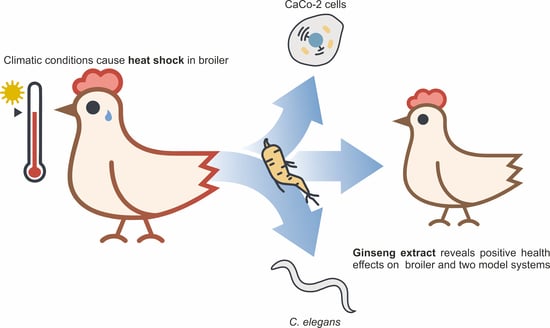Ginseng Extract Ameliorates the Negative Physiological Effects of Heat Stress by Supporting Heat Shock Response and Improving Intestinal Barrier Integrity: Evidence from Studies with Heat-Stressed Caco-2 Cells, C. elegans and Growing Broilers
Abstract
Share and Cite
Sandner, G.; Mueller, A.S.; Zhou, X.; Stadlbauer, V.; Schwarzinger, B.; Schwarzinger, C.; Wenzel, U.; Maenner, K.; van der Klis, J.D.; Hirtenlehner, S.; et al. Ginseng Extract Ameliorates the Negative Physiological Effects of Heat Stress by Supporting Heat Shock Response and Improving Intestinal Barrier Integrity: Evidence from Studies with Heat-Stressed Caco-2 Cells, C. elegans and Growing Broilers. Molecules 2020, 25, 835. https://doi.org/10.3390/molecules25040835
Sandner G, Mueller AS, Zhou X, Stadlbauer V, Schwarzinger B, Schwarzinger C, Wenzel U, Maenner K, van der Klis JD, Hirtenlehner S, et al. Ginseng Extract Ameliorates the Negative Physiological Effects of Heat Stress by Supporting Heat Shock Response and Improving Intestinal Barrier Integrity: Evidence from Studies with Heat-Stressed Caco-2 Cells, C. elegans and Growing Broilers. Molecules. 2020; 25(4):835. https://doi.org/10.3390/molecules25040835
Chicago/Turabian StyleSandner, Georg, Andreas S. Mueller, Xiaodan Zhou, Verena Stadlbauer, Bettina Schwarzinger, Clemens Schwarzinger, Uwe Wenzel, Klaus Maenner, Jan Dirk van der Klis, Stefan Hirtenlehner, and et al. 2020. "Ginseng Extract Ameliorates the Negative Physiological Effects of Heat Stress by Supporting Heat Shock Response and Improving Intestinal Barrier Integrity: Evidence from Studies with Heat-Stressed Caco-2 Cells, C. elegans and Growing Broilers" Molecules 25, no. 4: 835. https://doi.org/10.3390/molecules25040835
APA StyleSandner, G., Mueller, A. S., Zhou, X., Stadlbauer, V., Schwarzinger, B., Schwarzinger, C., Wenzel, U., Maenner, K., van der Klis, J. D., Hirtenlehner, S., Aumiller, T., & Weghuber, J. (2020). Ginseng Extract Ameliorates the Negative Physiological Effects of Heat Stress by Supporting Heat Shock Response and Improving Intestinal Barrier Integrity: Evidence from Studies with Heat-Stressed Caco-2 Cells, C. elegans and Growing Broilers. Molecules, 25(4), 835. https://doi.org/10.3390/molecules25040835







